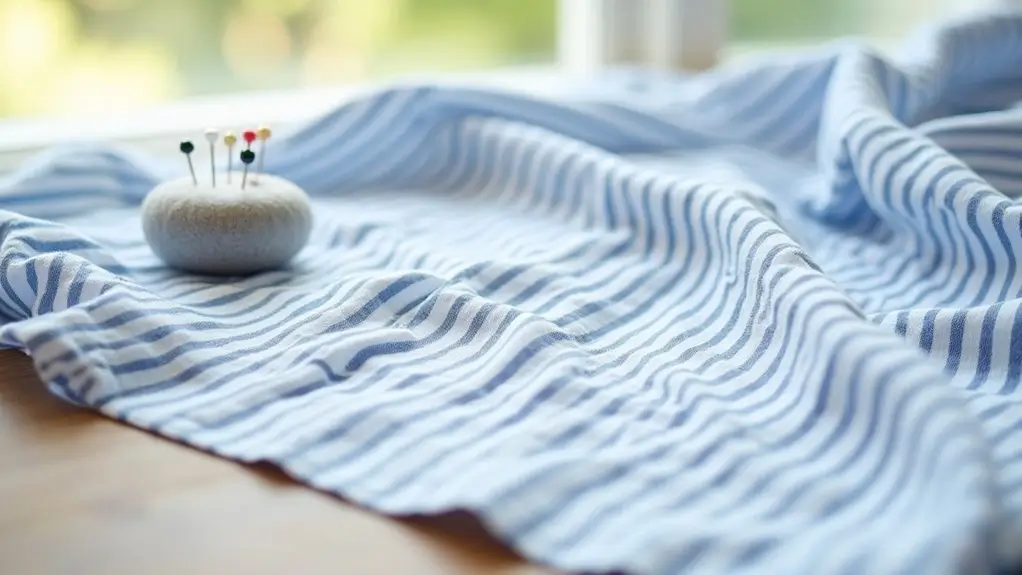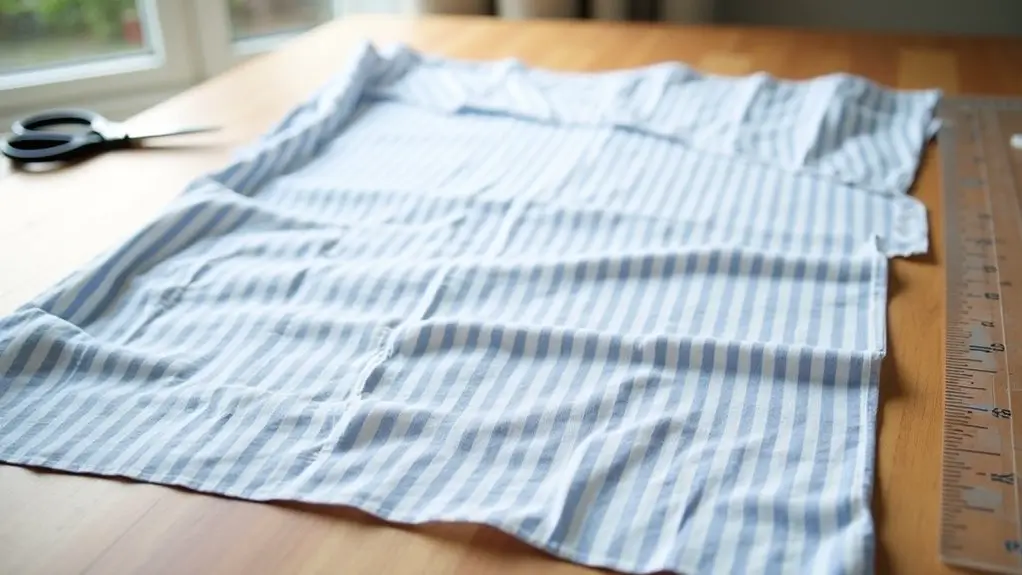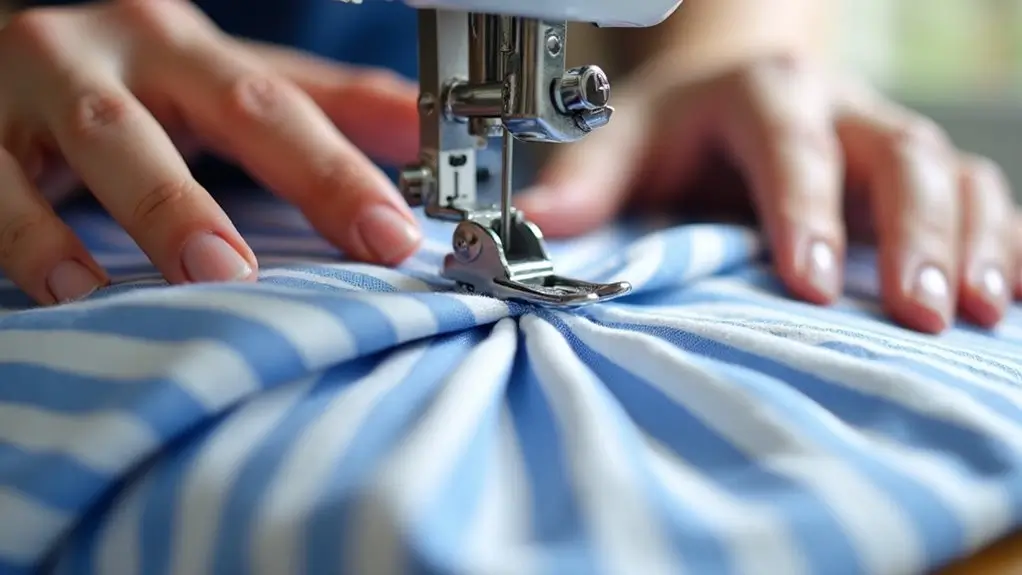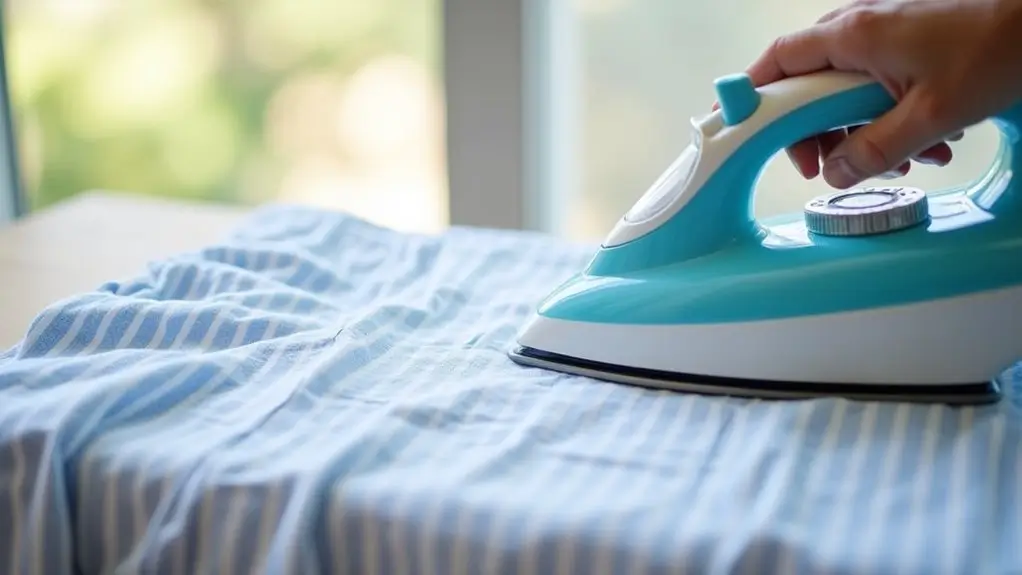If you're ready to tackle seersucker fabric, you need to understand its unique characteristics before making your first cut. This distinctive cotton material is well-known for its puckered texture and summer-friendly breathability. But it requires specific techniques to achieve professional results.
Seersucker's signature stripes and texture might seem challenging at first. But learning how to sew seersucker fabric will transform your next project from potentially frustrating to beautifully finished.
Key Takeaways
- Use pattern weights instead of pins when cutting. Pattern weights prevent distortion of the distinctive puckered texture.
- Pre-wash the seersucker in warm water and dry it before sewing. Doing so prevents future shrinkage issues.
- Match and align puckers carefully when joining seams. This ensures stripes and textures line up perfectly.
- Choose a size 70/80 universal needle and slightly looser tension for optimal sewing results.
- Press seams gently with low heat and a pressing cloth to maintain the fabric's natural wrinkled appearance.
Understanding Seersucker's Unique Properties

Many fabrics simply lay flat against your skin. But seersucker stands out with its distinctive puckered texture that creates raised ridges alongside smooth valleys. This unique texture isn't just for show. It's the result of a special weaving process that alternates tight and loose threads. This creates a fabric that naturally lifts away from your body.
Cotton seersucker's properties make it incredibly practical to work with. You'll find it's surprisingly lightweight and breathable, yet maintains excellent durability.
The non-clingy nature of seersucker means you won't struggle with fabric sticking to your machine while sewing. It's an ideal choice for both beginners and experienced sewists.
Essential Tools and Materials for Working With Seersucker
Working with seersucker fabric becomes more enjoyable when you've got the right tools at your fingertips. This lightweight, cotton fabric requires specific accessories to handle its unique puckered texture effectively.
For clean edges, you'll need sharp scissors or a rotary cutter. To prevent distortion, you'll also need pattern weights instead of pins.
Choose a size 70/80 universal needle for your sewing machine. Keep a pressing cloth handy for ironing.
Seersucker is durable and low-maintenance. With the right tools, your finished project will maintain its characteristic texture and professional appearance.
Proper Fabric Preparation and Layout Techniques

Proper fabric preparation will guarantee that your finished seersucker suit or blazer maintains its signature puckered texture. Pre-wash your fabric in warm water. Dry it according to care instructions to prevent future shrinkage.
When laying out your pattern pieces, follow the fabric's puckered grain lines. You should use pattern weights instead of pins to hold the pieces in place, as pins can distort the texture.
For beginners, it's helpful to mark your cutting lines with tailor's chalk. Do this on the smoother sections of the durable, breathable fabric.
How to Sew Seersucker Fabric for Perfect Puckers and Seams

Seven essential techniques guarantee your seersucker projects maintain their signature puckered charm during construction.
When sewing this lightweight fabric, you'll want to work with its natural properties rather than against them.
- Align the puckers carefully when sewing, ensuring stripes and textures match perfectly.
- Use a universal needle sized 70-80 and set your machine tension a bit looser than usual.
- Press seams gently to preserve the fabric’s natural puckered texture without flattening it.
- Avoid stretching or pulling the fabric. Let its natural texture guide your stitching.
- Cut on the smoothest sections for clear marking and easier handling.
- Use tailor’s chalk for marking to avoid damaging the delicate surface.
- Sew slowly to maintain control and prevent shifting of the puckered areas.
For best results, don't fight the fabric's natural texture. Let the puckered quality of seersucker guide your sewing methods. Then, you'll find it's surprisingly easy to work with.
Care and Maintenance of Seersucker Projects

Seersucker's natural puckering makes it relatively low-maintenance. But proper care guarantees your projects maintain their characteristic texture and vibrancy for years.
Seersucker fabric is easy to care for, as it's machine washable and highly absorbent. To prevent shrinkage, pre-wash your seersucker items in cool water before sewing.
Once completed, you can machine wash and dry your projects. But remember, air-drying helps maintain durability.
Due to the puckered texture, ironing isn't usually necessary. You can still press it on low heat if needed. Don't worry; the signature ripples will return after washing.
Final Words
You're now equipped to create beautiful seersucker projects with confidence. Remember to pre-wash your fabric, align those signature puckers carefully, and use the right tools for excellent results. When you follow the fabric's natural grain, you'll achieve professional-looking seams every time.
With these techniques in your sewing toolkit, you can transform this classic fabric into stunning garments and accessories that will last for years.
Learn more sewing tips on the Longan Craft Blog, and dive into the fabric world with Longan Craft!
FAQs
Can Seersucker Fabric Be Used for Winter Clothing With Proper Lining?
It's not ideal since seersucker is designed for summer. You'll get better results using traditional winter fabrics like wool or flannel.
Does Seersucker Fabric Fade Differently in Stripes Versus Solid Colors?
Striped seersucker tends to fade more evenly than solid colors. Because the puckered texture creates natural variations in wear.
Are Certain Thread Colors Known to Show Through Seersucker More Than Others?
Darker thread colors like navy and black tend to show through more on light seersucker. Matching thread colors blend better. White thread can be visible on darker seersucker stripes.
Can Seersucker Be Effectively Used for Structured Bags and Accessories?
Yes. Its durable texture holds shape nicely, though you'll want to add interfacing for extra stability. The puckered surface adds unique visual interest.
How Does Seersucker Perform When Used With Interfacing and Stabilizers?
Seersucker works well with interfacing and stabilizers. The fabric's puckered texture flattens slightly but maintains enough character. You can use lightweight to medium-weight interfacing without compromising the fabric's natural properties.


0 comments